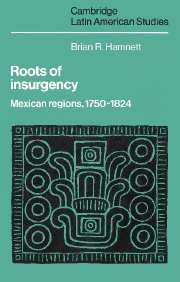Book contents
- Frontmatter
- Contents
- List of maps
- Acknowledgements
- Weights and measures
- Map 1 The viceroyalty of New Spain in 1810
- Introduction
- 1 Social tensions in the provinces
- 2 Insurgency — characteristics and responses
- 3 Conflict, protest and rebellion
- 4 Dearth and dislocation
- 5 Insurrection — recruitment and extension
- 6 The struggle for Puebla,1811–13
- 7 Local conflict and provincial chieftains
- 8 Conclusion
- Notes
- Bibliography
- Index
- CAMBRIDGE LATIN AMERICAN STUDIES
6 - The struggle for Puebla,1811–13
Published online by Cambridge University Press: 20 October 2009
- Frontmatter
- Contents
- List of maps
- Acknowledgements
- Weights and measures
- Map 1 The viceroyalty of New Spain in 1810
- Introduction
- 1 Social tensions in the provinces
- 2 Insurgency — characteristics and responses
- 3 Conflict, protest and rebellion
- 4 Dearth and dislocation
- 5 Insurrection — recruitment and extension
- 6 The struggle for Puebla,1811–13
- 7 Local conflict and provincial chieftains
- 8 Conclusion
- Notes
- Bibliography
- Index
- CAMBRIDGE LATIN AMERICAN STUDIES
Summary
The insurrection of September 1810 had not originated in the province of Puebla: no leaders of the early movement originated from that region. Nevertheless, by 1811 and 1812 the Intendancy of Puebla had become the ‘principal theatre of war’. This striking turn of events has received little comment or explanation. Its significance has largely been misread. As a result, we have a distorted view of this turning-point in the war in New Spain. From the secondary literature we have a disjointed narrative, a series of set pieces, such as the sieges of Cuautla, Huajuapan and Acapulco, the capture of Oaxaca, and the deliberations of the Congress of Chilpancingo. From these fragments we cannot piece together the image at the centre of the picture. What we lack, then, is the centre piece, the explanation to the broken picture. This key lies not in an examination of these peripheral incidents, so often reiterated in the literature, but in a direct confrontation with the archival materials concerning the long neglected battle for Puebla in the years, 1811 and 1812. Without such a study the set pieces around the perimeter of the main theatres of action lose their significance, which lay in their relation to the struggle for control of the central cereal-producing valleys.
Early insurgent activity in the Puebla region
Long-standing grievances in several localities provided a fertile recruiting ground for insurgent bands. Osorno and Aldama, as we have seen, operated across the Llanos de Apan and into the sierras of northern Puebla.
- Type
- Chapter
- Information
- Roots of InsurgencyMexican Regions, 1750–1824, pp. 150 - 177Publisher: Cambridge University PressPrint publication year: 1986



